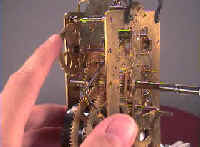Why does the clock chime and strike at the wrong time?
Tick Tock Productions �
-Antique clock repair courses-
Home Page
There is more than one function involved for an antique clock to correctly chime and strike. The strike will sound on the hour and half hour, or only on the hour. The clock will chime on each quarter hour and chiming longer at each quarter hour.
Usually, the chime and strike are two separate parts of the clock movement. They each will have their own winding hole for the key. Each has their own mainspring that powers either the chime or the strike and separate gear trains. Some clocks are self regulating. Most are not.
It is possible to strike at the correct time and chime at the wrong time. Setting the antique clock to chime and strike at the correct times can be very confusing for the average person who has no knowledge of clock movements.
Setting a clock to chime and strike are two different independent adjustments. It is easier to correct the chime first, and the strike second.
The time and strike getting out of sync can occur when the mainspring of either mechanism runs down as the clock continues to run. The antique clock can continue to strike while the chime has run down. Winding up the chime side usually starts the chime from where it last stopped. That is how it loses its' sequence. Similarly the strike side will start to strike from the hour it wound down although the clock continued to run and it is now a different hour.
Learn clock repair with these DVD courses! Course manuals are included.
Watch, study and learn antique clock repair through DVD course instruction using actual live repairs!!
Clock Repair 1 & 2 Advanced Clock Repair
PROFESSIONAL advanced clock repair
Clockmaker Watchmaker Lathe Basics Clockmaker Watchmaker Lathe Projects Clock Case Repair & Restoration Wooden Works Movement Repair
Copyright 2001-2023 by Tick Tock Productions Copyright 2001-2023 by John Tope All rights reserved.
